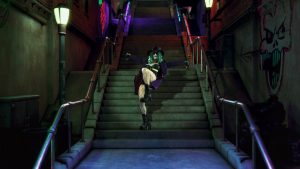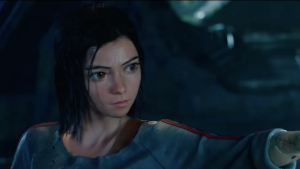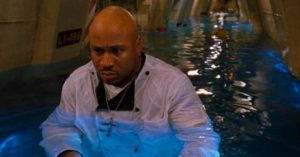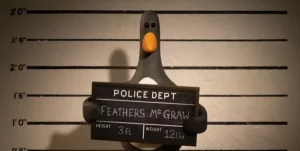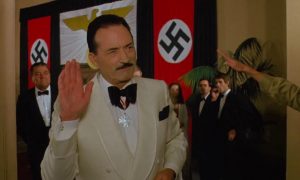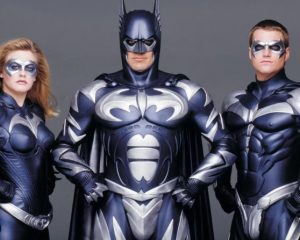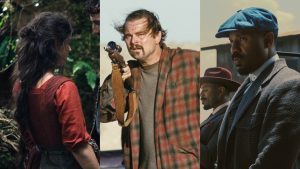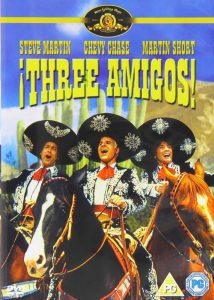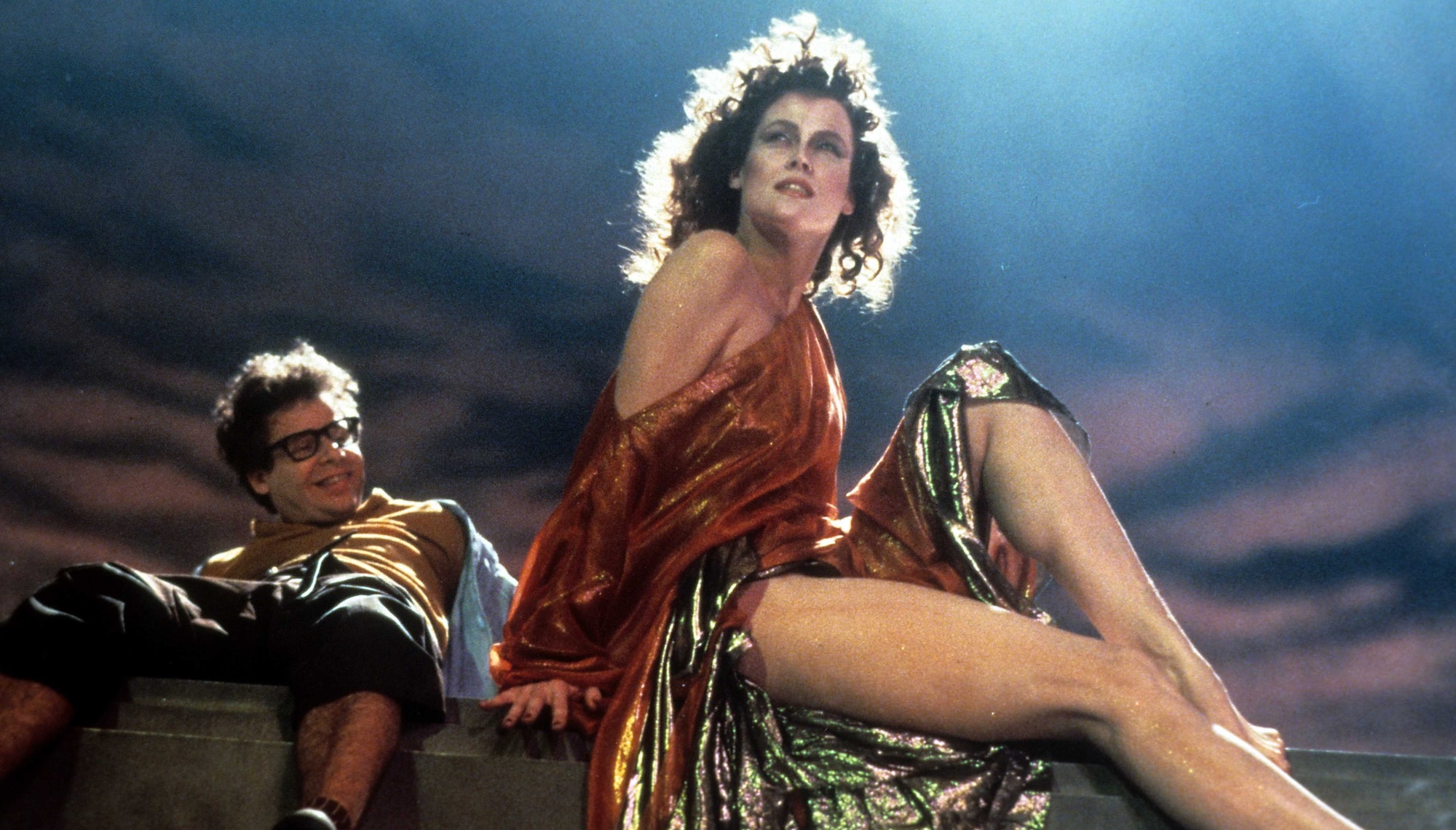
Columbia Pictures never wanted to make Ghostbusters. Well, to put a finer point on it, those who technically ran the studio out of New York City (then as a Coca-Cola subsidiary) wanted no part in the catching ghost business—so much so that lawyers got involved. But by the time the Manhattan executives heard about the project, the Columbia Pictures chairman out in actual Hollywood, Frank Price, had already greenlit the movie and put a seeming target on his back.
Such was the opinion of “high-concept” and special effects-driven comedies in the early 1980s.
Released 40 years ago this month, Ghostbusters has obviously outlived those early doubts. It’s a pop culture touchstone with the same kind of tenacity Slimer displays at a wedding reception buffet. There’s always room for more bustin’, whether it be by way of loving tributes to this classic of 1980s comedy, or through new attempts to expand the brand. There have been cartoon shows, cult video game darlings, and a franchise still producing sequels for Columbia’s current owners, Sony Entertainment. Ghostbusters truly is a one-of-a-kind phenomenon, but back at its inception it was the most unusual of ideas: an expensive, VFX-heavy comedy with actors who only a few years earlier boasted on television that they were the “Not Ready for Primetime.”
In its own perverse way, Ghostbusters helped pave the way for the Hollywood blockbusters we have today.
There were of course hit comedies before Ghostbusters; there were even hit comedies starring many of the guys who made bustin’ feel good. Dan Aykroyd, who originated the idea for Ghostbusters based on his own family’s fascination with spiritualism and the occult, had starred in Trading Places (1983) and The Blues Brothers (1980). Both films pitted Ayrkoyd across fellow veterans of the television series that redefined American comedy in the 1970s, Saturday Night Live. In fact, Aykroyd envisioned Ghostbusters to be another vehicle for himself and his SNL partner-in-crime, John Belushi, until the latter died of a drug overdose while Ayrkoyd was still writing the first draft.
Bill Murray, meanwhile, spread his wings from SNL and flew in films like Meatballs (1979) and, more impressively, Caddyshack (1980) and Stripes (1981). There was a new wave of comedy actors coming out of New York (which itself was odd at the time considering how few television stars ever crossed over into movies). Still, the idea of what a comedy was to Hollywood had not fundamentally changed since the days of the Marx Brothers.
The American studio comedy was definitely becoming cruder and raunchier in the ‘70s after the Hays censorship code finally died its last agonizing breath. Belushi, for instance, was the first SNL alum to have a bonafide hit in Animal House (1978)—a movie it should be noted that made the career of its producer and future Ghostbusters director, Ivan Reitman. And that frat house favorite is as celebrated as it is reviled to this day for its depiction of sex, drugs, and booze on college campuses (plus the heavy implication of date rape being common). Yet these were all small-time programmers as far as their studios were concerned.
Universal Pictures made Animal House for $3 million and cast a bunch of unknowns, plus that uproarious guy on late night TV; Meatballs was made for less than a million dollars; and Stripes came in at the high-end with a $10 million price tag. These were all studio movies trying to ride the new wave in comedic talent, sure, but they were intended to be actor and situation driven. The most spectacular effect in the $6 million-budgeted Caddyshack was a gopher that swayed back and forth to Kenny Loggins.
Then there was Ghostbusters, a concept that Aykroyd originally intended to feature the Stay Puft Marshmallow Man by page 10. One of the many compromises that occurred after Reitman and co-writer Harold Ramis came along is that they’d save Mr. Stay Puft’s stroll down 8th Ave. until the 90-minute mark.
Nonetheless, even pared down into the more attainable movie Ghostbusters became during a fast-paced rewriting process, the film was conceptually more in line with the new era of special effects blockbusters ushered in by filmmakers like Steven Spielberg and George Lucas than it was in-tune with the SNL or National Lampoon aesthetic. Hence why Ghostbusters precipitated the creation of a new special effects company, Richard Enlund’s Boss Studios, because Lucas’ ILM was tied up bringing Return of the Jedi and Indiana Jones and the Temple of Doom to life.
So the brass at Columbia’s had reason to sweat when they discovered Price fast-tracked Ghostbusters without a finished script in 1983 for a proposed budget of $25 million (it ended up costing $30 million, or about $95 million in 2024 dollars).
“It was a horrendous amount of money for a comedy,” Price recalled to Lesley M. M. Blume and Vanity Fair in 2014. It was also based on a figure of $25 million that Reitman apparently pulled out of thin air; it simply sounded right to nearly triple Stripes’ price tag. At that point, Ramis had not begun rewriting the script with Ayrkoyd, and even Murray’s involvement was still technically in doubt.
While Murray apparently told Ayrkoyd he would do it before Reitman and Ramis came aboard, Murray didn’t sign his name to a contract for Ghostbusters until Columbia also greenlit Murray’s passion project, a straight-faced drama adaptation of W. Somerset Maugham’s novel, The Razor’s Edge. It was yet one more gamble on studio’s part, with the expectation it would “lose little or no money,” just to finesse Ghostbusters into existence. All this to release a movie in which SNL guys would save Sigourney Weaver after she turned into a dog.
Francis “Fay” Vincent, the CEO of Columbia Pictures Industry, working under Coke, sent his “top lawyer” out to Hollywood as soon as he heard about the deal so as to pressure Price into canceling the movie. “It was too expensive, too risky,” Price recalled being told. “I explained ‘I’ve got Bill Murray. I was going to go ahead with it.’ They made it clear that it was my responsibility. I was out on the limb.”
Price of course wound up being vindicated. Despite Reitman’s agent hearing “we all make mistakes” after industry executives screened Ghostbusters without laughing once, the film went on to be one of the biggest movies of its decade. It posted Columbia’s best opening weekend ever up to that point, and it tapped into the ‘80s zeitgeist in a way few other comedies ever managed. Its success is mostly a credit to its various oddball talents blending together in a totally unpredictable fashion: Aykroyd and Ramis’ surprisingly erudite script; the chemistry of the five leads which also included Ramis, Weaver, and Ernie Hudson; and Reitman’s shrewdly understated direction, which caused the shockingly sophisticated special effects to pop all the more in front of audiences who two years earlier were paying to watch that Caddyshack gopher.
It invented the pricey, visual effects-heavy comedy. A case can be made, then, that it even continues to influence the modern blockbusters of today. While casting outright comedians in the lead roles is a practice that has withered as studios in general continue to move away from the type of laughers that were made before Ghostbusters—character and/or star-driven scenarios that don’t need a 10-figured VFX budget—there is no denying the DNA of Ghostbusters was visible in many high-concept movies of the ’80s, ‘90s, and 2000s. Galaxy Quest (which also starred Weaver), Men in Black (which was also made by Columbia), and Evolution (directed by Reitman) immediately spring to mind.
Even 40 years later, if you squint, the disaffected, tongue-in-cheek smirk that seemed so mischievous on Murray has become part and parcel for the modern blockbuster formula, albeit now on more traditionally good-looking movie star faces. Shots of Chris Evans, Scarlett Johansson, and Jeremy Renner running down a New York City street as they stare up at a giant-sized monster threat in 2012’s The Avengers is always reminiscent of three schmucks in silly outfits running across Central Park West in the lead up to fighting a Marshmallow Man; popular talents behind much of the current superhero craze, including Chris Pratt, Paul Rudd, Ryan Reynolds, Taika Waititi, and Kumail Nanjiani, all come from the world of comedy; and blockbusters in general tend to feature at least one Venkman-like character who looks perpetually over it when things get weird.
Ghostbusters is a perfect movie: a 105-commitment to the bit that plays its concept both straight and bemused at the same time. It was a trailblazer that set a tone and style that’s still chased—albeit less and less by its sequels.
The post How Ghostbusters Invented the VFX-Driven Blockbuster Comedy appeared first on Den of Geek.
